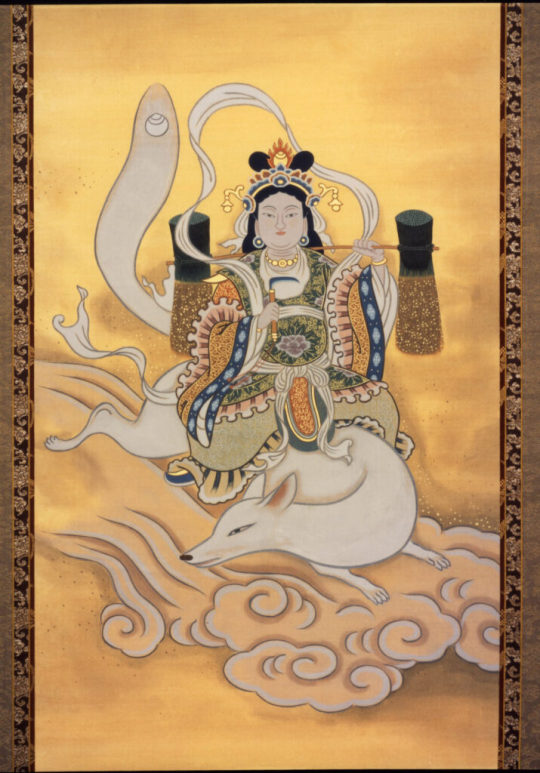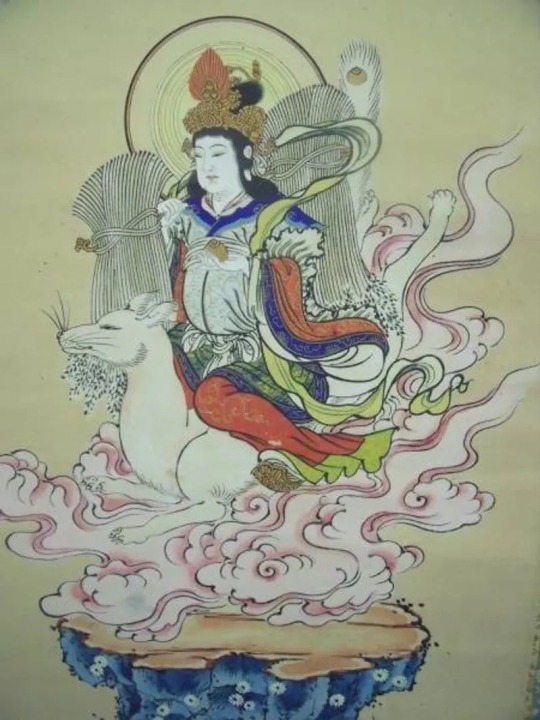#myokyoji
Text

Inari Daimyōjin (稲荷大明神) as a goddess riding a fox from Saijō Inarisan Myōkyōji Temple (最上稲荷山妙教寺) in Okayama City, Okayama Prefecture
Image from the temple's official website
#japanese art#buddhist art#稲荷#inari#稲荷大明神#inari daimyojin#岡山県#okayama prefecture#岡山市#okayama#妙教寺#myokyoji#最上稲荷山妙教寺#saijo inarisan myokyoji#日蓮宗#nichiren buddhism#nichiren#arte budista#arte japonés
50 notes
·
View notes
Text
Saijō-i Kyō-ō Dai-zenjin (Inari)
The deity Saijō-i Kyō-ō Dai-zenjin is commonly referred to as “O-Inari-san”, and is sometimes believed to have the form or appearance of a fox, however this is a misunderstanding. The Eternal Buddha, who is without form, appears for the sake of all sentient beings in the form of this bodhisattva who is a protector deity of the Lotus Sūtra.
“Saijō-i”, which means “highest ranked” indicates that this deity is ranked highest among all gods. “Kyō-ō” which means “Sūtra King” shows that among all the many Buddhist sūtras, the hidden truth that Śākyamuni Buddha is the Eternal Buddha, our Original Teacher, is only expounded in the Lotus Sūtra, or Myōhō Renge Kyō. “Dai-zenjin” means “great benevolent deity”.
In other words, Saijō-i Kyō-ō Dai-zenjin is a manifestation of the wonderful power, which is beyond human understanding, contained in the Lotus Sūtra which we receive and uphold.
Saijō-i Kyō-ō Dai-zenjin’s appearance is usually that of a beautiful woman with a bundle of rice on her left shoulder holding a sickle in her right hand, accompanied by a white fox holding a wish-fulfilling gem (Cintāmaṇi) in its mouth.
The bundle of rice symbolises the fact that the Venerable Saijō-i is a deity of the five grains, meaning she protects our lives with food. The sickle, taken together with the rice bundle, is a widely used set representing farming, and taking care of and dispersing evil. The wish-fulfilling gem in the fox’s mouth signifies the fulfilment of wishes and good luck. That Saijō-i Kyō-ō Dai-zenjin travels or rides on a white fox symbolises her purity, and white is also symbolic of her mysterious spiritual ability to appear and disappear like a phantom.
The misconception that Inari is a fox seems to be so widespread perhaps due to a common fear of the spiritual power of foxes in Japan.
As a deity representing the wisdom of the Lotus Sūtra, Inari is invoked in many Nichiren Shu temples. Especially famous are the Fushimi, Yūtoku and Toyokawa Inari shrines which are known as the “Three Great Inari of Japan”, as well as the Nichiren Shu temple called “Saijō Inari-san Myokyoji” in Okayama Prefecture.
You can find Inari-san enshrined in many people’s homes, along with Daikokuten, the god of happiness, wealth and longevity, and the water deities “Hachi Dai-ryū-ō” (the Eight Great Dragon Kings).
In: https://nichiren-shu.org.uk/shugojin-1

20 notes
·
View notes
Text

An ofuda talisman depicting Inari Daimyōjin (稲荷大明神) as a goddess riding a fox from Saijō Inarisan Myōkyōji Temple (最上稲荷山妙教寺) in Okayama City, Okayama Prefecture
#buddhist art#御札#talisman#稲荷#inari#稲荷大明神#inari daimyojin#岡山県#okayama prefecture#岡山市#okayama#妙教寺#myokyoji#最上稲荷山妙教寺#saijo inarisan myokyoji#日蓮宗#nichiren buddhism#nichiren#arte budista
40 notes
·
View notes
Text

A view of the 77 subordinate shrines (七十七末社) enshrining various local deities serving as attendants and assistants of Inari Daimyōjin (稲荷大明神) at Saijō Inarisan Myōkyōji Temple (最上稲荷山妙教寺) in Okayama City, Okayama Prefecture
Image from the temple's official website
#buddhist temple#岡山県#okayama prefecture#岡山市#okayama#妙教寺#myokyoji#最上稲荷山妙教寺#saijo inarisan myokyoji#鳥居#torii#日蓮宗#nichiren buddhism#nichiren#templo budista
18 notes
·
View notes
Text
Daily worshipping according the Saijo Inari-san Myokyoji Temple
The Saijo Inari-san Myokyoji Temple follows a shinbutsu tradition focused on the devotion of Saijō-i Kyō-ō Daibosatsu, also known as O-Inari-san.
Following are instructions for daily worshipping that come directly from correspondence I had with the Saijo Inari-san Myokyoji Temple itself.
Please take this merely as referential information and If you want to know more contact directly the Saijo Inari-san Myokyoji Temple in [email protected]
Setting up a Kamidana:
1. The Kamidana should be placed in the northwest on the wall above the line of sight and facing to the southeast.
2. You should place an Ofuda or statue in the Kamidana.
3. The recommended offerings are candles, incense and sasaki.
4. Kitsune, shimenawa, banners or other additional items are facultative.
Basic worshipping:
1. With the palms placed together in Gassho recite one or three times: Namu Myoho Renge Kyo or Namu Saijō-i Kyō-ō Daibosatsu.
2. Pray sincerely with all your heart.
3. Separate your hands after you finish praying.
Note: The Saijo Inari-san Myokyoji Temple does not ship Ofuda overseas, however, it is acceptable to pray to Saijō-i Kyō-ō Daibosatsu in front of any Ofuda of Inari Omikami-sama.
16 notes
·
View notes